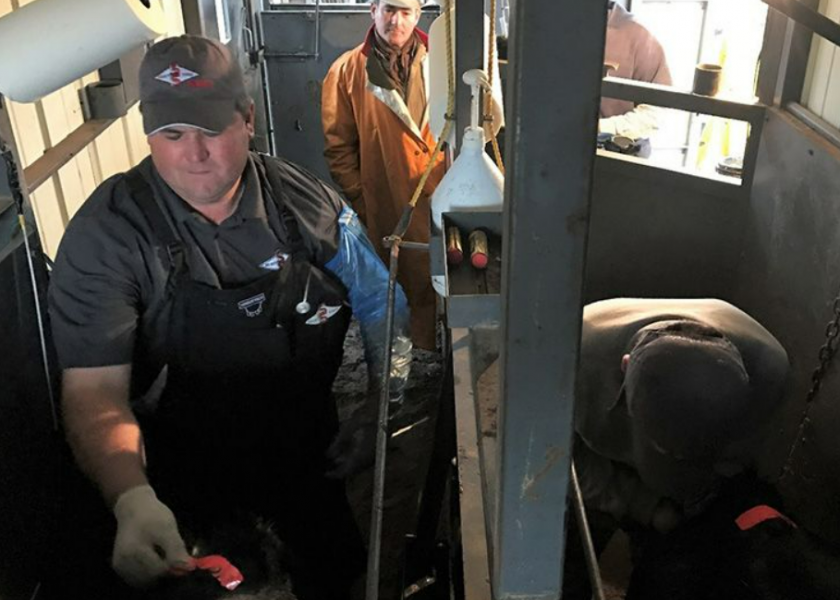3 Keys for Successful Beef Cattle Artificial Insemination

Breeding productivity with artificial insemination (AI) has come a long way on U.S. cattle ranches.
Advancements in technology and research show improvements in breeding results and confidence in AI across the country. Use of AI rose 4% in the U.S. from 2007 to 2017, with 11.6% of beef operations implementing AI during 2017, according to the USDA National Animal Health Monitoring System’s (NAHMS) Beef survey reports from those years.
“Using AI in a herd requires a long-term approach,” says Clint Sexson, large herd specialist for All West Beef/Select Sires. “The rewards may not be instantaneous, but a view toward the future can lead to gains in the overall herd management program.”
In the western U.S. where Sexson breeds thousands of beef cattle each year, AI has more momentum than the national average; 13.6% of western operations use the breeding tactic. Sexson says successful AI takes a willingness to accept advice and adjust management strategies that work for your herd.
Here are three keys to help set an AI breeding program up for success.
1. Prepare year-round for more pregnancies.
It takes a year-round focus to get cows and heifers ready for AI. But, it doesn’t require anything out of the ordinary. Just good management principles.
Start by having cattle in good body condition score (BCS).
“As old as the concept of body condition scoring is, a lot of producers underestimate by a full body condition score,” says Sexson. “It’s super costly when a cow’s body condition score is too low because she won’t breed back in a timely manner.”
Ideally, cows and heifers should be in an average BCS 4.5 to 6 year-round. Following calving they may dip below that mark, so plan to provide supplemental nutrition to set them up for breeding success.
Good health also allows females to perform well reproductively. If you can coordinate vaccinations and deworming ahead of breeding, you will provide extra immune support so the body can focus on reproduction.
The reproductive tract plays an integral role. For virgin heifers, taking pelvic scores and rectally palpating the reproductive tract ahead of breeding can save time and money – allowing you to avoid spending resources on females that aren’t ready or won’t breed.
Sexson recommends against AI for cows that have a tough time calving because their reproductive tracts might be damaged. Make sure to take note of any cows needing assistance during the calving season.
Handling cattle using low-stress techniques matters, too.
“At the chute when breeding cattle, a technician can see and feel an obvious difference between cattle that have been mishandled and those that are handled carefully,” says Sexson. “Stressed or mishandled females won’t be easy to breed, and this can negatively affect breeding rates.”
2. Breed using visual estrus detection.
The traditional method of estrus detection is to watch cattle mount one another and look for hair being rubbed on the backside. But there are existing tools to make this easier. Tools such as breeding indicator patches help visibly show estrus activity so you can save time by not watching cattle all day.
A breeding indicator patch helps identify when cattle are expressing high estrus intensity indicated by more mounting activity. As mounting activity occurs, the patch surface ink rubs off to expose a bright indicator color.
Sexson routinely uses breeding indicator patches when AI breeding, and his preferred protocol is split-time AI. He applies breeding indicator patches after pulling CIDRs (controlled intravaginal drug release) and then observes the results 60 hours later. At this point, Sexson likes to see 55% to 65% of cattle expressing high estrus intensity by observing at least half of the surface ink rubbed off the patches.
“If I wait another 12 to 18 hours, which would be 72 to 78 hours after applying the patches, estrus expression rises to 75% to 85% of the herd,” says Sexson. “That high level of estrus intensity across the herd drives up conception.”
High estrus intensity occurs when at least 50% of the surface ink is rubbed off breeding indicator patches. Cattle can be bred with more success when estrus intensity is high. High estrus intensity also leads to less embryonic losses after breeding. Should patches have less than 50% of surface ink rubbed off, consider using cheaper straws of semen because the likelihood of pregnancy is reduced.
“Using a breeding indicator patch in any breeding protocol is an insurance policy to let me know if anything might have gone wrong during the process and to better time breeding across the herd,” says Sexson.
3. Set realistic expectations, see economic returns.
Getting 100% of the herd to settle and breed to first service AI is a lofty goal. However, it isn’t necessarily realistic. Having half the herd or more breed to AI is more in line with industry standards and is beneficial to overall herd profitability.
“If you have 100 cows, and you want 50% of them calving the first 10 days of the calving season, your bulls are not going to accomplish that,” says Sexson. “It’s not that the bulls can’t breed the cows. The cows just aren’t going to be set up in such a fashion that you’re going to get 50% of the calves in 10 days.”
Sexson says it’s possible to get 60% or 70% of the herd bred in the first 30 days with natural service if your management is good. With AI, you can get 70% of the herd successfully bred on the first service. This puts you in position for most of your herd to calve in the first 10 days. Frontloading the calving season with AI helps raise weaning weights because the average age of calves rises. You can also reap the benefits of uniform calf crops at marketing to help benefit your bottom line.
For more information on breeding indicator patches, visit ESTROTECT.com.







